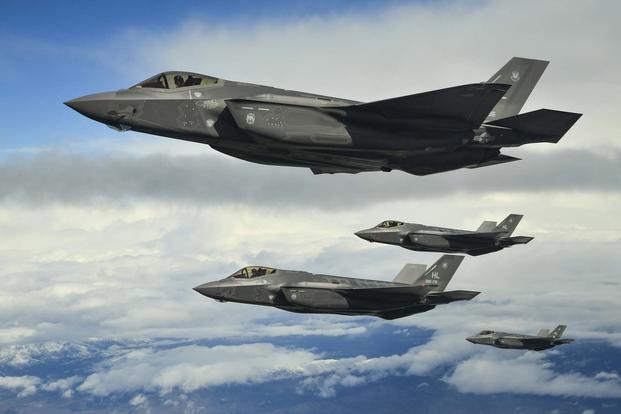The F-35A Joint Strike Fighter is ready and poised to go to the Pacific -- or any theater, for that matter -- should tensions escalate with North Korea, the Air Force's top civilian said Friday.
"We now just passed 100,000 flying hours with the F-35, and it is doing very well and in any contingency, if there were a problem, they're ready to go -- ready to go to combat," Air Force Secretary Heather Wilson told reporters during a briefing at the Pentagon.
While she didn't speak to potential overseas rotation schedules for the Air Force's version of the stealthy fifth-generation fighter, she said "everything is on track" for identifying more stateside bases to house more of the aircraft rolling off Lockheed Martin Corp.'s production line.
The secretary's comments come at a time when North Korea continues to threaten and challenge the U.S. Both President Donald Trump and Defense Secretary James Mattis recently indicated they'd be willing to respond with military force should North Korea launched any missile at Guam, where the U.S. maintains air and naval bases.
Related content:
- Dunford on North Korea: 'Get Out of This Situation Without a War'
- Peeking into the Air Force's F-35 Training Course
- Air Force Sees Unique Challenges in Deploying Stealth Fighters
Earlier this month, North Korea's leader Kim Jong Un threatened to launch a salvo of four missiles that would splash down in waters within 25 miles of the U.S. territory of Guam. U.S. President Donald Trump responded with a Tweet that said the country is "locked and loaded" for a conflict with North Korea.
The U.S. military has since repeatedly sent B-1B supersonic bombers and South Korean fighter jets in a show of force near the demilitarized zone. Meanwhile, the Air Force's F-35A has yet to make its debut in the Pacific theater. (The Marine Corps this year deployed a squadron of F-35Bs to Iwakuni, Japan.)
In April, the Air Force dispatched a handful of F-35As overseas to Europe for several weeks in the aircraft's first training deployment to the continent.
In recent months, service officials said they plan to rotate a "theater security package" of F-35As to the Asia-Pacific region. Such a rotation includes forward-deployed aircraft and units that conduct missions across the continent over six months to reassure allies.
It could come sooner than expected.
"We do expect to busy, and we do expect to be on the move quite a bit," 1st Lt. Brett Burnside, a brand-new F-35 Lightning II pilot, told Military.com recently about his training at Luke Air Force Base, Arizona. Burnside is next headed to the 34th Fighter Squadron at Hill Air Force Base, Utah -- one of four U.S. F-35A locations.
"I know we have some stuff planned for the future -- theater security packages -- but I can't really speak to that," he said.
Wilson also said she's concerned pilots may be at higher risk for mishaps because of the high operational tempo of missions around the globe.
"I worry about that -- I think we should all worry about that," Wilson said. "When we characterize our readiness levels, we prioritize being in the current fight and the nuclear mission. That means that some of the missions against integrated air defenses, we're not as ready. That doesn't mean we won't go. It means fewer will come back. I think we need to understand that."










